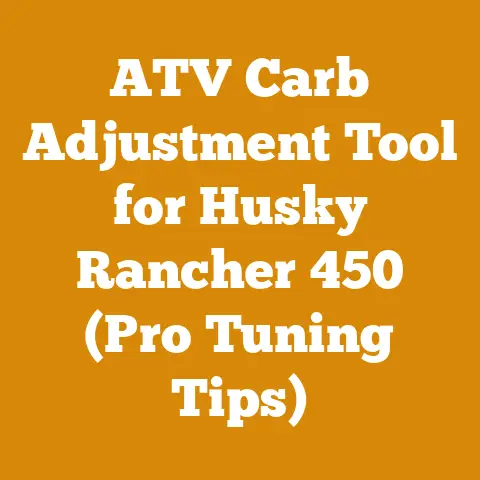How to Bleed Air Out of Hydraulic Cylinders (Woodworking Hacks)
Understanding Hydraulic Systems in Woodworking Equipment
Hydraulic systems are the backbone of many woodworking and logging tools, providing the power needed for tasks like log splitting, lifting, and pressing. These systems rely on the incompressibility of hydraulic fluid to transmit force. However, air, unlike hydraulic fluid, is compressible. When air enters the system, it disrupts the transfer of force, leading to inefficiencies and potential damage.
Why Air Enters Hydraulic Cylinders
Air can enter a hydraulic system through several ways:
- Loose Fittings: Connections that aren’t properly tightened can allow air to seep in.
- Low Fluid Levels: If the reservoir runs low, the pump can suck in air along with the fluid.
- Damaged Seals: Worn or damaged seals on the cylinder rod or pump can allow air to enter.
- Fluid Contamination: Using the wrong type of hydraulic fluid or fluid that is contaminated can cause foaming and air entrainment.
- During Maintenance: Opening the system for repairs or fluid changes can introduce air.
The Impact of Air in Hydraulic Systems
The presence of air in a hydraulic cylinder can manifest in several ways:
- Reduced Power: The cylinder may not be able to generate its full force, making it difficult to split tough logs.
- Erratic Movement: The cylinder may move in a jerky or uneven manner.
- Spongy Feel: The hydraulic system may feel soft or spongy when operated.
- Overheating: Air can cause the hydraulic fluid to overheat, potentially damaging the pump and seals.
- Premature Wear: The presence of air can accelerate wear and tear on hydraulic components.
Identifying Air in Your Hydraulic Cylinder
Before diving into the bleeding process, it’s crucial to confirm that air is indeed the culprit behind your hydraulic system’s woes. I’ve found that a systematic approach to diagnosis saves time and prevents unnecessary repairs.
Common Symptoms of Air in Hydraulic Cylinders
Here’s a checklist of symptoms that often indicate air in the system:
- Symptom 1: Reduced Power and Speed: The cylinder extends or retracts slower than usual, even when under no load. This is often the first sign that something is amiss. Imagine trying to split a seasoned oak log, and the splitter hesitates or struggles – a clear red flag.
- Symptom 2: Spongy or Jerky Movement: The cylinder movement feels uneven, almost like it’s stuttering. You might experience a “bouncing” effect during operation. I once had a log splitter that would lurch forward and then pause, making it incredibly difficult to control.
- Symptom 3: Unusual Noises: Gurgling, hissing, or squealing sounds coming from the hydraulic system can indicate air being compressed and released. These noises are especially noticeable when the cylinder reaches the end of its stroke.
- Symptom 4: Overheating: The hydraulic pump or cylinder becomes excessively hot to the touch after only a short period of operation. Air increases friction and reduces the system’s ability to dissipate heat.
- Symptom 5: Foaming Fluid: Inspect the hydraulic fluid reservoir. If the fluid appears milky or foamy, it’s a strong indication that air is present.
Diagnostic Tests to Confirm Air Presence
While symptoms provide clues, performing diagnostic tests offers more concrete evidence.
- Test 1: Visual Inspection of Hydraulic Fluid: Check the hydraulic fluid level in the reservoir. Low fluid levels can introduce air into the system. Also, examine the fluid’s color and consistency. Milky or foamy fluid indicates air contamination.
- Test 2: Cylinder Extension Test: Fully extend the hydraulic cylinder and observe its behavior. If it extends smoothly and consistently, air is less likely to be the problem. However, if it hesitates, sputters, or exhibits jerky movements, air is likely present.
- Test 3: Cylinder Retraction Test: Retract the cylinder and observe its behavior. Similar to the extension test, any erratic movements or noises suggest air in the system.
- Test 4: Pressure Test (Advanced): This test requires a hydraulic pressure gauge. Connect the gauge to a test port on the cylinder or hydraulic pump. Operate the cylinder and monitor the pressure reading. A fluctuating or lower-than-expected pressure indicates air in the system. Note: This test should be performed by someone familiar with hydraulic systems and safety procedures.
Safety Precautions Before Bleeding
Hydraulic systems operate under high pressure, making safety paramount. Before attempting to bleed air from a hydraulic cylinder, I always follow these critical safety precautions:
- Personal Protective Equipment (PPE):
- Safety Glasses: Essential to protect your eyes from hydraulic fluid splashes.
- Gloves: Wear heavy-duty gloves to protect your hands from hydraulic fluid and sharp edges. Nitrile gloves are a good option as they are resistant to hydraulic fluid.
- Steel-Toed Boots: Protect your feet from falling objects and potential spills.
- Equipment Preparation:
- Secure the Equipment: Ensure the log splitter or woodworking machine is on a stable, level surface. Engage any safety locks or parking brakes to prevent movement.
- Disconnect Power Source: For electric-powered equipment, unplug the power cord. For gasoline-powered equipment, turn off the engine and disconnect the spark plug wire.
- Relieve Pressure: Before disconnecting any hydraulic lines, relieve the pressure in the system. Some equipment has a pressure relief valve that can be used for this purpose. Consult the owner’s manual for specific instructions.
- Hydraulic Fluid Handling:
- Contain Spills: Have absorbent materials (e.g., rags, spill pads) readily available to clean up any spills.
- Proper Disposal: Dispose of used hydraulic fluid properly. Do not pour it down the drain or onto the ground. Contact your local recycling center or hazardous waste disposal facility for guidance.
- Work Area Safety:
- Clear the Area: Remove any obstructions or tripping hazards from the work area.
- Ventilation: Work in a well-ventilated area to avoid inhaling hydraulic fluid fumes.
- Emergency Preparedness:
- First Aid Kit: Keep a well-stocked first aid kit nearby in case of injury.
- Emergency Contact Information: Have emergency contact information readily available.
Methods for Bleeding Air from Hydraulic Cylinders
There are several methods for bleeding air from hydraulic cylinders. The best approach depends on the type of equipment, the severity of the air contamination, and your level of experience. I’ll cover three common methods, starting with the simplest and progressing to more advanced techniques.
Method 1: The Simple Cycling Method
This is often the first method I try, as it’s the least invasive and requires no special tools. It relies on the natural movement of the cylinder to expel air.
Step-by-Step Guide:
- Inspect Fluid Level: Ensure the hydraulic fluid reservoir is filled to the proper level. Low fluid levels can exacerbate air entry.
- Start the Equipment: If the equipment is engine-powered, start the engine. If it’s electric, plug it in and turn it on.
- Cycle the Cylinder: Extend and retract the cylinder fully, several times. Operate the cylinder slowly at first, then gradually increase the speed. The goal is to allow any trapped air to migrate towards the reservoir.
- Monitor Fluid Level: As you cycle the cylinder, monitor the fluid level in the reservoir. Air being expelled from the system will cause the fluid level to fluctuate. Add fluid as needed to maintain the proper level.
- Listen for Air: Pay close attention for any gurgling or hissing sounds coming from the cylinder or hydraulic pump. These sounds indicate air being expelled.
- Repeat if Necessary: Continue cycling the cylinder for several minutes, or until the symptoms of air contamination disappear.
Data Points and Technical Notes:
- Optimal Cycling Speed: Start with slow cycling to allow air bubbles to coalesce and rise to the surface. Gradually increase the speed to dislodge any stubborn air pockets.
- Fluid Level Monitoring: Maintain the fluid level within the recommended range specified in the equipment’s owner’s manual. Overfilling can cause fluid to spill during operation.
- Observation Time: Allow at least 15-20 minutes of cycling to ensure thorough bleeding.
- Expected Outcome: You should notice a gradual improvement in the cylinder’s performance, with smoother and more consistent movement.
- Limitations: This method is most effective for minor air contamination. If the system is heavily contaminated, a more aggressive approach may be necessary.
Method 2: The Bleed Screw Method
Many hydraulic cylinders are equipped with bleed screws, also known as bleeder valves. These screws provide a direct path for air to escape from the cylinder.
Step-by-Step Guide:
- Locate the Bleed Screw: The bleed screw is usually located on the cylinder body, near the hydraulic fittings. Consult the equipment’s owner’s manual for the exact location.
- Prepare a Container: Place a container beneath the bleed screw to catch any escaping hydraulic fluid.
- Loosen the Bleed Screw: Using a wrench, carefully loosen the bleed screw. Do not remove it completely. Just loosen it enough to allow fluid and air to escape.
- Cycle the Cylinder: Extend and retract the cylinder slowly. As the cylinder moves, air and fluid will be forced out through the bleed screw.
- Tighten the Bleed Screw: Once the fluid flowing from the bleed screw is free of air bubbles, tighten the screw. Do not overtighten it, as this can damage the threads.
- Repeat if Necessary: Repeat the process several times, or until all the air is bled from the cylinder.
Data Points and Technical Notes:
- Bleed Screw Torque: Refer to the equipment’s owner’s manual for the recommended torque specification for the bleed screw. Overtightening can damage the threads or the screw itself. A typical torque range is 5-10 Nm (4-7 ft-lbs).
- Fluid Collection: Use a clear container to collect the escaping hydraulic fluid. This allows you to easily observe the presence of air bubbles.
- Cylinder Positioning: Position the cylinder so that the bleed screw is at the highest point. This allows air to naturally rise to the bleed screw.
- Observation Time: Allow sufficient time for all the air to escape. This may take several minutes, depending on the severity of the air contamination.
- Limitations: Some cylinders may not have bleed screws. In this case, another method will be necessary.
Method 3: The Hydraulic Line Loosening Method (Advanced)
This method involves loosening the hydraulic lines connected to the cylinder to allow air to escape. This method should only be attempted by experienced individuals who are familiar with hydraulic systems and safety procedures.
Step-by-Step Guide:
- Identify Hydraulic Lines: Identify the hydraulic lines connected to the cylinder. There are typically two lines: one for extending the cylinder and one for retracting it.
- Prepare a Container: Place a container beneath the hydraulic line connection to catch any escaping hydraulic fluid.
- Loosen the Hydraulic Line: Using a wrench, carefully loosen the hydraulic line connection. Do not remove it completely. Just loosen it enough to allow fluid and air to escape.
- Cycle the Cylinder: Extend and retract the cylinder slowly. As the cylinder moves, air and fluid will be forced out through the loosened hydraulic line.
- Tighten the Hydraulic Line: Once the fluid flowing from the hydraulic line is free of air bubbles, tighten the connection. Do not overtighten it, as this can damage the threads.
- Repeat for Other Line: Repeat the process for the other hydraulic line connected to the cylinder.
- Repeat if Necessary: Repeat the entire process several times, or until all the air is bled from the cylinder.
Data Points and Technical Notes:
- Hydraulic Line Torque: Refer to the equipment’s owner’s manual for the recommended torque specification for the hydraulic line connections. Overtightening can damage the threads or the fittings. A typical torque range is 20-30 Nm (15-22 ft-lbs).
- Fluid Collection: Use a clear container to collect the escaping hydraulic fluid. This allows you to easily observe the presence of air bubbles.
- Line Selection: Start with the hydraulic line that is located at the highest point on the cylinder. This allows air to naturally rise to the connection.
- Observation Time: Allow sufficient time for all the air to escape. This may take several minutes, depending on the severity of the air contamination.
- Limitations: This method can be messy, as hydraulic fluid will likely spill. It also carries a higher risk of introducing contaminants into the hydraulic system.
Case Study: My Log Splitter Rescue
I remember one particularly frustrating experience with my log splitter. I had just purchased a load of seasoned oak, ready to tackle a winter’s worth of firewood. But after only a few logs, the splitter started acting up. The cylinder moved slowly and jerkily, and I could hear a distinct gurgling sound. I initially suspected a hydraulic pump failure, but after some troubleshooting, I realized it was simply air in the system.
I started with the simple cycling method, but it didn’t seem to make much difference. Then, I located the bleed screw on the cylinder and tried that method. After several cycles, I could see air bubbles escaping from the bleed screw. Gradually, the splitter’s performance improved, and the jerky movements disappeared. After about an hour of bleeding, the splitter was back to its full power, and I was able to finish splitting the oak without any further issues.
This experience taught me the importance of regular maintenance and troubleshooting. It also highlighted the effectiveness of the bleed screw method for removing air from hydraulic cylinders.
Preventing Air from Entering Hydraulic Systems
While knowing how to bleed air is essential, preventing it from entering in the first place is even better. Here are some proactive measures I take to keep my hydraulic systems running smoothly:
- Regular Fluid Level Checks: Check the hydraulic fluid level in the reservoir regularly. Low fluid levels are a common cause of air entry. I make it a habit to check the fluid level before each use.
- Proper Fluid Selection: Use the correct type of hydraulic fluid specified in the equipment’s owner’s manual. Using the wrong type of fluid can cause foaming and air entrainment. I always stick to the recommended fluid and avoid mixing different types.
- Data Point: ISO Viscosity Grade (VG) is a common specification for hydraulic fluids. Using the correct VG is crucial for optimal performance.
- Tighten Fittings: Ensure all hydraulic fittings are properly tightened. Loose fittings can allow air to seep in. I periodically check and tighten all fittings to prevent leaks.
- Technical Note: Use a torque wrench to tighten fittings to the recommended specification. Overtightening can damage the threads.
- Inspect Seals: Regularly inspect the seals on the cylinder rod and pump for wear or damage. Replace any damaged seals promptly. I replace seals preventatively every few years, depending on usage.
- Data Point: Seal materials vary depending on the application. Common materials include nitrile rubber (NBR), Viton (FKM), and polyurethane (PU).
- Proper Maintenance: Follow the manufacturer’s recommended maintenance schedule for the equipment. This includes changing the hydraulic fluid and filters at the specified intervals. I keep a log of all maintenance activities to ensure I don’t miss any important tasks.
- Technical Note: Hydraulic fluid should be changed every 500-1000 hours of operation, or every 1-2 years, whichever comes first.
- Avoid Overheating: Overheating can cause the hydraulic fluid to break down and create air bubbles. Avoid operating the equipment for extended periods under heavy loads. I take frequent breaks to allow the system to cool down.
- Data Point: Maximum operating temperature for hydraulic fluid is typically around 82°C (180°F).
- Use a Filter: Install a hydraulic filter to remove contaminants from the fluid. Contaminants can damage the pump and seals, leading to air entry. I use a high-quality filter with a micron rating appropriate for my equipment.
- Technical Note: Filter micron rating indicates the size of particles that the filter can remove. A lower micron rating indicates a finer filter.
- Proper Storage: Store the equipment in a clean, dry environment. This helps to prevent corrosion and damage to the hydraulic components. I cover my equipment when it’s not in use to protect it from the elements.
Troubleshooting Common Issues After Bleeding
Even after successfully bleeding air from a hydraulic cylinder, some issues may persist. Here’s a guide to troubleshooting common problems and their potential solutions:
- Issue: Cylinder Still Moves Jerkily:
- Possible Cause: Residual air in the system, damaged cylinder rod, or worn seals.
- Troubleshooting Steps:
- Repeat the bleeding process, paying close attention to any gurgling or hissing sounds.
- Inspect the cylinder rod for scratches or dents. Replace the cylinder if necessary.
- Replace the cylinder seals.
- Issue: Cylinder Leaks Hydraulic Fluid:
- Possible Cause: Loose fittings, damaged seals, or cracked cylinder body.
- Troubleshooting Steps:
- Tighten all hydraulic fittings to the recommended torque specification.
- Replace the cylinder seals.
- Inspect the cylinder body for cracks. Replace the cylinder if necessary.
- Issue: Cylinder Doesn’t Extend or Retract Fully:
- Possible Cause: Low hydraulic fluid level, clogged filter, or damaged pump.
- Troubleshooting Steps:
- Check the hydraulic fluid level and add fluid as needed.
- Replace the hydraulic filter.
- Inspect the hydraulic pump for damage. Replace the pump if necessary.
- Issue: Hydraulic Pump Overheats:
- Possible Cause: Low hydraulic fluid level, clogged filter, or damaged pump.
- Troubleshooting Steps:
- Check the hydraulic fluid level and add fluid as needed.
- Replace the hydraulic filter.
- Inspect the hydraulic pump for damage. Replace the pump if necessary.
- Issue: Hydraulic System Makes Excessive Noise:
- Possible Cause: Low hydraulic fluid level, air in the system, or damaged pump.
- Troubleshooting Steps:
- Check the hydraulic fluid level and add fluid as needed.
- Repeat the bleeding process.
- Inspect the hydraulic pump for damage. Replace the pump if necessary.
Advanced Hydraulic System Maintenance
For those looking to delve deeper into hydraulic system maintenance, here are some advanced techniques and considerations:
- Hydraulic Fluid Analysis:
- Purpose: To assess the condition of the hydraulic fluid and identify potential problems.
- Procedure: Collect a sample of hydraulic fluid and send it to a laboratory for analysis. The analysis will provide information about the fluid’s viscosity, contamination levels, and wear debris.
- Benefits: Early detection of problems, extended fluid life, and reduced equipment downtime.
- Pressure Testing:
- Purpose: To verify that the hydraulic system is operating at the correct pressure.
- Procedure: Connect a hydraulic pressure gauge to a test port on the system. Operate the equipment and monitor the pressure reading. Compare the reading to the manufacturer’s specifications.
- Benefits: Identification of pressure leaks, pump problems, and valve malfunctions.
- Flow Testing:
- Purpose: To measure the flow rate of hydraulic fluid in the system.
- Procedure: Connect a hydraulic flow meter to a test port on the system. Operate the equipment and monitor the flow reading. Compare the reading to the manufacturer’s specifications.
- Benefits: Identification of pump problems, valve malfunctions, and flow restrictions.
- Component Overhaul:
- Purpose: To restore hydraulic components to their original condition.
- Procedure: Disassemble the component, clean and inspect all parts, replace worn or damaged parts, and reassemble the component.
- Benefits: Extended component life, improved performance, and reduced equipment downtime.
- System Design Considerations:
- Purpose: To optimize the design of hydraulic systems for specific applications.
- Considerations: Fluid type, pump size, valve selection, cylinder size, and filtration requirements.
- Benefits: Improved efficiency, reduced energy consumption, and extended equipment life.
Conclusion: Mastering Hydraulic System Maintenance
Bleeding air from hydraulic cylinders is a critical skill for anyone working with woodworking or logging equipment. By understanding the causes of air contamination, recognizing the symptoms, and mastering the bleeding techniques outlined in this guide, you can keep your equipment running smoothly and avoid costly repairs. Remember to prioritize safety, follow the manufacturer’s recommendations, and perform regular maintenance to prevent air from entering the system in the first place.
From my own experiences, I can tell you that a little preventative maintenance goes a long way. Taking the time to check fluid levels, tighten fittings, and inspect seals can save you hours of frustration and keep your projects on schedule. And when air does find its way into the system, don’t panic. Follow the steps in this guide, and you’ll be back up and running in no time.
The satisfaction of working with well-maintained equipment is a reward in itself. It allows you to focus on the task at hand, whether it’s splitting firewood for a cozy winter evening or crafting a beautiful piece of furniture. So, take care of your hydraulic systems, and they’ll take care of you. Happy woodworking!






